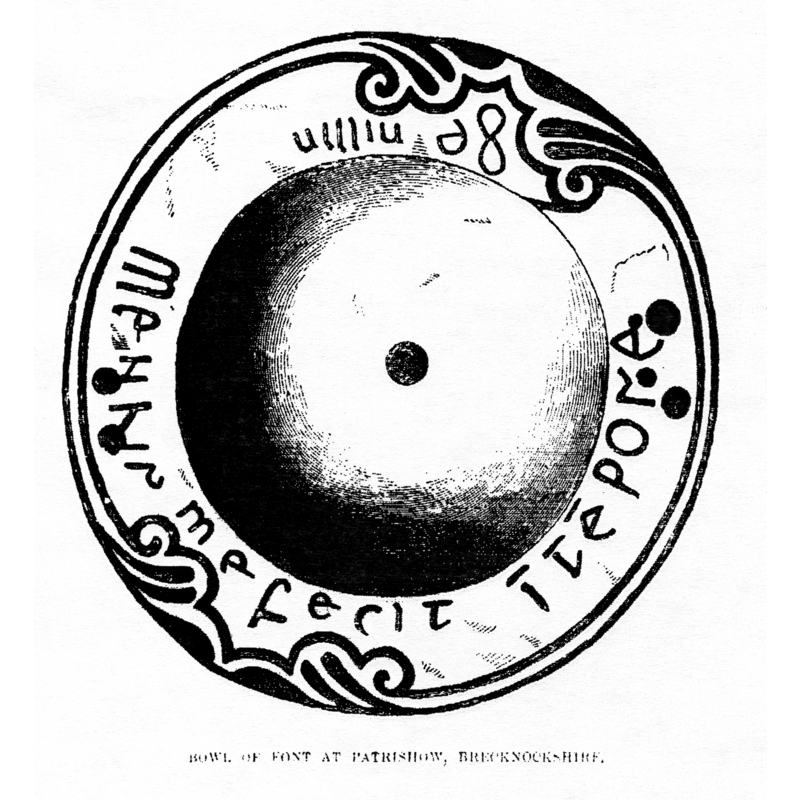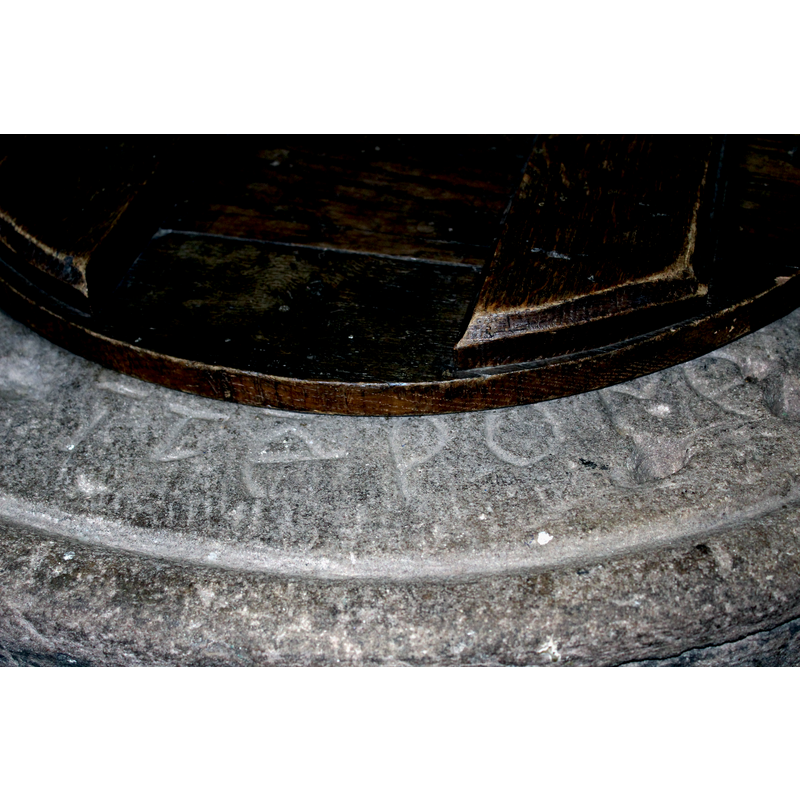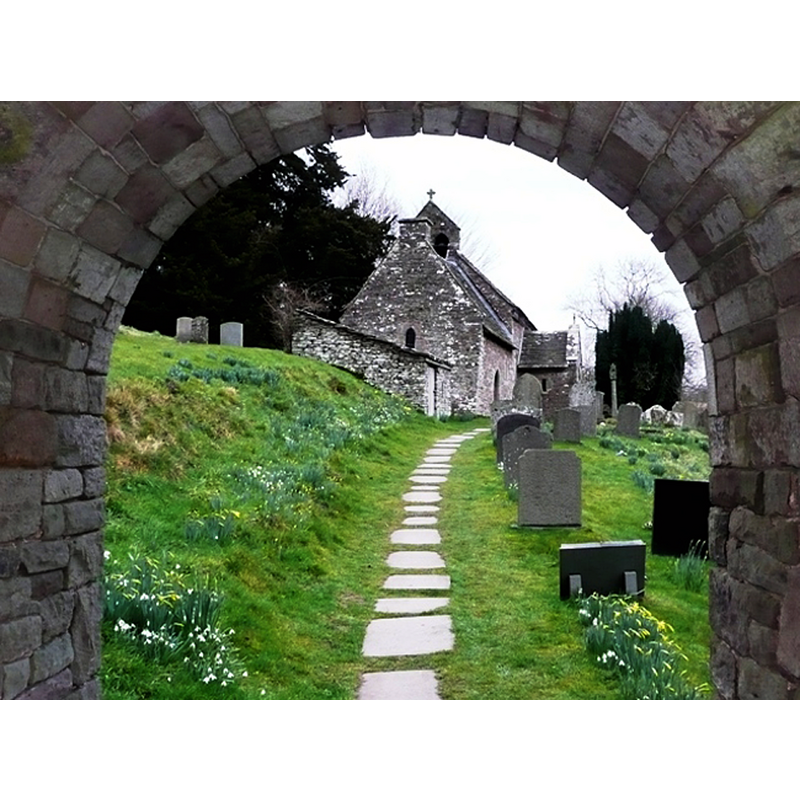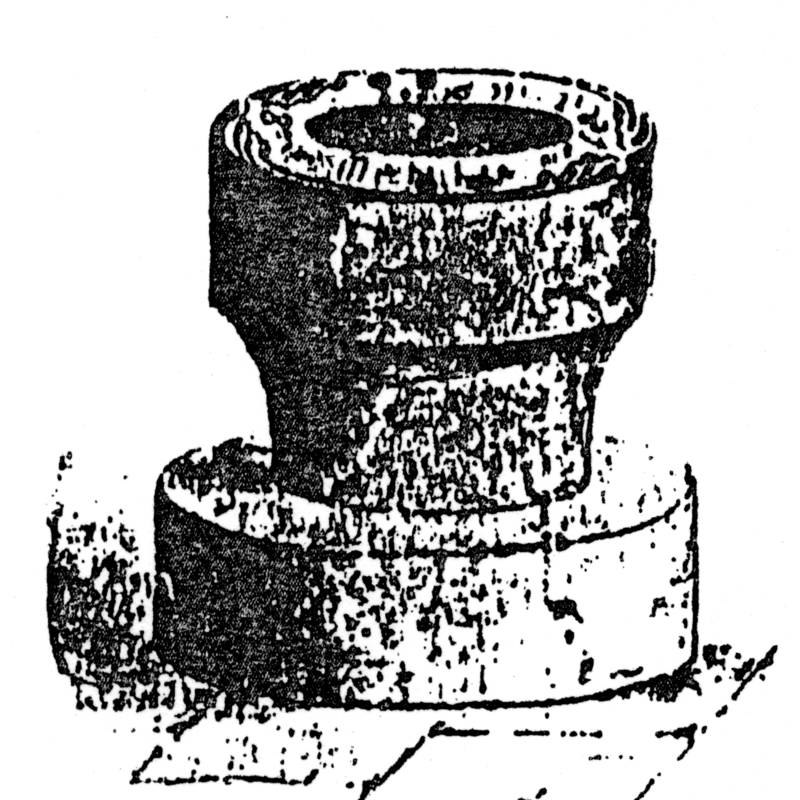Partrishow No. 1 / Patricio / Patrisio / Patrishow
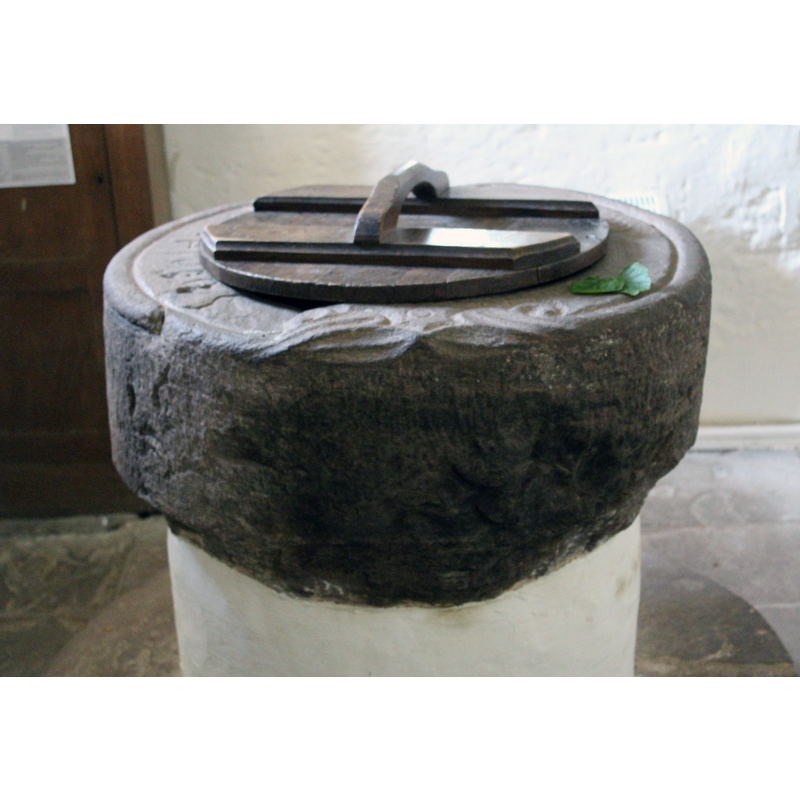
Image copyright © David F. Goda, 2016
Image and permission received (e-mail of 16 July 2016)
Results: 15 records
design element - motifs - foliage
design element - motifs - roll moulding
Scene Description: as seen in this photograph, the rim moulding is not a complete circle, but end here on a lovely foliage curl; the opposite end, believed to have been originally a similar motif was probably damaged at some point and looks rough now [or was unfinished?]
Copyright Statement: Image copyright © David F. Goda, 2016
Image Source: digital photograph taken 6 July 2016 by David F. Goda
Copyright Instructions: Image and permission received (e-mail of 16 July 2016)
inscription
inscription
inscription
inscription
inscription - detail
view of basin - detail
view of church exterior - northeast view
view of font
view of font
view of font and cover
Scene Description: as photographed in July 2011
Copyright Statement: Image copyright © David Pike, 2011
Image Source: digital photograph taken 1 July 2011 by David Edward Pike [http://daibach-welldigger.blogspot.ca/2011_07_01_archive.html] [accessed 26 April 2012]
Copyright Instructions: Permission received (David Pike's e-mail of 27 April 2012)
view of font and cover - upper view
INFORMATION
FontID: 05598PAT
Object Type: Baptismal Font1
Church/Chapel: Parish Church of St. Issui
Church Patron Saints: St. Issui [aka Ishow]
Church Location: Vale of Grwyney, Powys, Powys NP7 7LP
Country Name: Wales
Location: Powys
Directions to Site: Located 10 km N of Abergavenny, 10 km NE of Crickhowell, in the Brecon Beacons National Park
Ecclesiastic Region: Diocese of St. David's
Historical Region: formerly Brecknockshire
Font Location in Church: Inside the church, to the left (W) of the entrance
Date: ca. 1060?
Century and Period: 11th century [basin only], Pre-Conquest
Workshop/Group/Artisan: Master (?) Menhir?
Credit and Acknowledgements: We are grateful to David Pike, and to David F. Goda for thier photographs of this font
Church Notes: Tyrrell-Green (1928: 151): "The church at Patricio was dedicated by Bishop Herwald of Llandaff about the year 1060, and it is quite likely that the font was placed within it at the time it was built, so that it would belong to the period before the Norman Conquest, and the Genillin named is identified by Westwood with Genillin Foel, who was Prince of Powys in the middle of the eleventh century".
Font Notes:
Click to view
Noted in Lewis' Dictionary edition of 1849. Described and illustrated with measurements and record of the inscription in Westwood, in Archaeologia Cambrensis (1856) and (1876-1879), and Bloxham (Archaeologia Cambrensis (1874). Described and illustrated in Romilly Allen (1888), who reckons that "if we accept the identification of Genillin [cf. infra] with ther Prince of Powis of the same name, this font must be ascribed to the middle of the eleventh century". Described and illustrated in Bond (1908) as one of the oldest baptismal fonts in Wales; it "may be attributed either to the end of the eleventh or to the beginning of the twelfth century [...o]n account of the identification of a name mentioned in the inscription"; other sources have proposed earlier dates for this object but, as has been pointed out, it does not follow that antiquity be based simply the crude rendering of it. The upper surface of the rim has an inscription with the name of the master ["Menhir"] and a reference to the period in which it was done ["in tempore Genillin"]; there are two foliage motifs at opposite ends of the rim, next to the inscription; there are also two pairs of holes, also at opposite ends, evidence of lid hardware. The font is raised on a wider cylindrical plinth. Described and illustrated in Tyrrell-Green (1928): "bowl and shaft [...] hewn out of single stone"; he adds that the inscription assigns this font to a pre-Conquest date and that the text of it most likely does not make a reference to "Menhir" master at all [cf. Inscription notes below]. Described and illustrated in Nash-Williams (1950), who dates the font to the late 11th or 12th century, describes the lettering as "Hiberno-Saxon minuscules" and translates the inscription as "Menhir made me in the time of Genillin". Thurlby (2006) sees no reason to doubt the 1060 dating that coincides with the dedication of the church itself. Noted in Jenkins (2008). The basin may have been intended originally to be placed against a wall, as one of the sides is rough, and the details unfinished. [cf. Index entry for Partrishow No. 2 for a 14th-century stoup in the gatehouse]
COORDINATES
Church Latitude & Longitude Decimal: 51.89564, -3.049783
Church Latitude & Longitude DMS: 51° 53′ 44.3″ N, 3° 2′ 59.22″ W
UTM: 30U 496574 5749432
MEDIUM AND MEASUREMENTS
Material: stone
Font Shape: cylindrical (mounted)
Basin Interior Shape: round
Basin Exterior Shape: round
Rim Thickness: 15 cm*
Diameter (inside rim): 50 cm***
Diameter (includes rim): 80 cm* / 85 cm** / 85 cm***
Notes on Measurements: * Nash-Williams (1950: 79) as: 32" diam. x 6" w. (across rim) / ** Romilly Allen (1888: 167) as 2 ft. 10 in. in diameter / *** Westwood (1876-1879: 71) as 34" of external diameter and 20" internal
INSCRIPTION
Inscription Language: Latin
Inscription Notes: Tyrrell-Green (1928: 150-151) gives two versions of the translation:
1.- the most usual rendition: MENHIR MADE ME IN THE TIME OF GENILLIN
2.- what he believes the true meaning is: I WAS MADE OUT OF A SINGLE STONE IN THE TIME OF GENILLIN
Inscription Location: on the upper rim surface
Inscription Text: "MENHIR ME FECIT I[N] TE[M]PORE GENILLIN"
Inscription Source: Westwood (1876-1879: 71); Romilly Allen (1888: 167); Tyrrell-Green (1928: 151); Bond (1985 c1908: 107); Nash-Williams (1950: fig. 53 and pl. LXIII)
LID INFORMATION
Date: modern
Material: wood
Apparatus: no
Notes: two pairs of holes at opposite ends of the upper rim; evidence of old cover hardware; the current [2010] font cover is moder, of a rustic desgin. a round base with two planks and a handle across
REFERENCES
The Visual Culture of Wales = Diwylliant gweledol Cymru, Cardiff: University of Wales Press, 1998-2003
Allen, J. Romilly, "On the Antiquity of Fonts in Great Britain", XLIV, Journal of the British Archaeological Association, 1888, pp. 164-173; p. 167, 173 and ill. on p. opposite p. 167
Bond, Francis, Fonts and Font Covers, London: Waterstone, 1985 c1908
Cox, John Charles, Nottinghamshire, London: Allen, 1912
Friar, Stephen, The Sutton Companion to Churches, Thrupp, Stroud (Gloucs.): Sutton Publishing, 2003
Jenkins, Simon, Wales: Churches, Houses, Castles, London: Allen Lane, 2008
Kroesen, Justin E.A., The Interior of the medieval village church = Het middeleeuwse Dorpskerkinterieur, Leuven: Uitgeverij Peeters, 2004
Lewis, Samuel, A Topographical Dictionary of England, Comprising the Several Counties, Cities, Boroughs, Corporate and Market Towns, Parishes, Chapelries, and Townships, and the Islands of Guernsy, Jersey, and Man, with Historical and Statistical Descriptions [...], London: S. Lewis, 1831
Mehling, Franz N., Great Britain and Ireland: a Phaidon Cultural Guide, Englewood Cliffs, NJ: Prentice-Hall, 1985
Nash-Williams, Victor Erle, The Early Christian Monuments of Wales, Cardiff: University of Wales Press, 1950
Thurlby, Malcolm, Romanesque architecture and sculpture in Wales, Little Logaston, Woonton, Almeley, Herts.: Logaston Press, 2006
Tyrrell-Green, E., Baptismal Fonts Classified and Illustrated, London: Society for Promoting Christian Knowledge: The Macmillan Co., 1928
Westwod, John Obadiah, Lapidarium Walliæ: the Early Inscribed and Sculptured Stones of Wales, delineated and described, Oxford: Printed at the University Press for the Cambrian Archælogical Association, 1976-1879

![[cf. Inscription area and Font notes]](/static-50478a99ec6f36a15d6234548c59f63da52304e5/compressed/0020207151_compressed.png)
